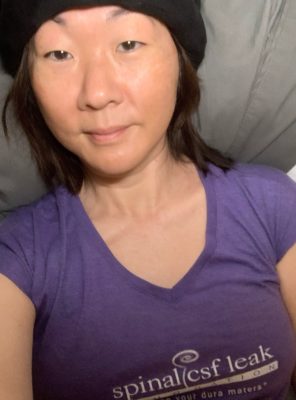Connie Rim shared her thoughts with us about how she plans to participate in this year’s #duradash. Visit her #duradash page to see progress updates and to give your support!

Connie, who is 48, acquired two spinal CSF leaks during surgery. One was repaired shortly thereafter, but the other was not discovered until exploratory surgery a year later. Unfortunately, she continues to leak from an elusive area and has undergone a third surgery and 11 epidural blood patches to date.
What are you doing for #duradash?
I am planning to use my time to spread spinal CSF leak awareness through my Facebook blog and simply working on overcoming my daily physical and emotional well-being since having fallen bedridden to this illness 2 years ago.
What to you want people to know about spinal CSF leak?
Symptoms, severity, diagnosis, and treatments may vary from patient to patient. My spinal CSF leak is not simply a “headache.” It has completely disabled me and confined me to a dark room, lying down 24/7 with pain, nausea, and a myriad of neurological complications. I believe that knowledge, patience, advanced technology, and a willingness to learn and listen will help to alleviate the pain and eventually find a cure for all who are suffering.
What research on spinal CSF leak do you hope to see in future?
I’d love to see research on how autoimmune disorders, general anatomy, menstrual cycles, stress, and various other factors affect spinal CSF leaks and symptoms, as well as research on complex imaging, so spinal CSF leaks may be more easily found with better technology.
